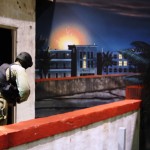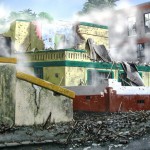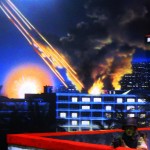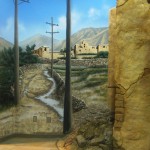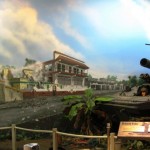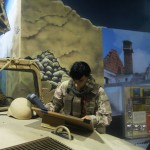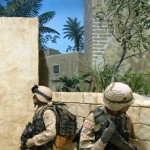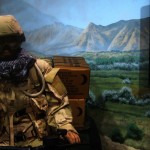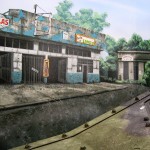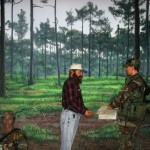One of the most fascinating jobs I’ve done was for the Airborne Special Operations Museum outside Fort Bragg, North Carolina.
The Museum specializes in the history of special forces starting with World War II and covering the Green Berets up through Iraq and Afghanistan.
One of their biggest and most dramatic exhibits is on Operation Gambit, a secret mission that no one had learned of before this exhibit was built. It involved the rescue of an American citizen, Kurt Muse, from Manuel Noriega’s most infamous prison on the night before the invasion of Panama in 1989.
Unfortunately the mission was so secret that the Museum couldn’t get adequate information enough for me to be able to design the mural. After much hemming and hawing and my having to explain that I have an FBI file and had a top-secret clearance in the service, they cautiously allowed me to see some aerial photos of the prison after the raid. From these photos I was able to construct an idea of the surrounding neighborhood.
The rescue was conducted by a special forces team based in Florida that had practiced for weeks on a scale model of the prison. They came in on six tiny helicopters, landed on the prison roof, set up a defensive perimeter, and blew the door off a central cupola that led downstairs to Kurt’s cell. They stuffed him into one of the helicopters but it was hit taking off and lost lift, crash-landing in the street between the prison and Noriega’s heavily armed military headquarters. Unable to fly, the team drove down the street, hung a left and disappeared into Panama City to be rescued by ground troops at dawn.
The finished mural featured apartment buildings, some of which were on fire, and some distant explosions against the night sky, with a tall hill in back. The rest of the exhibit was a recreation of the prison roof with manikins aiming their weapons over the perimeter wall while other manikins blew the door open. Above was a “little bird” helicopter with eight operatives riding on the skins.
As I was putting the last touches on a palm tree, I heard a conversation approaching up the hallway. It was the Museum director with a short, balding fellow saying, “It looks pretty good, but there needs to be a lot more explosions and tracer rounds coming out of the sky like a red curtain all the way around the building. It was deafening.”
I turned around. The guy smiled and I asked, “Are you Kurt?”
He shook my hand and said simply, “Yes.”
It turned out I was not finished with the mural. I added a lot more pyrotechnics until he was satisfied. I also got a first-hand description of his experience. He was at the Museum to promote his new book, Six Minutes to Freedom (Citadel Press, 2006).
Later, two of the operatives, now retired, came to visit the exhibit and make a few corrections for me. They didn’t look as I expected: they looked more like bearded biker dudes and were very soft-spoken, somewhat contradicting the Hollywood image I had.
This experience was topped only by working with veterans on murals for the National Museum of the Marine Corps.
